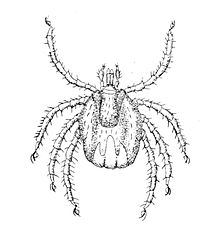en
names in breadcrumbs


Ixodes is currently the largest genus of hard ticks, with around 250 described species. They have a 3-host life cycle and many species inhabit nests or burrows. Relatively few species parasitize larger mammals. Ixodes ricinus and I. persulcatus are well known Eurasian species, whereas I. scapularis is the most common Ixodes in North America, with a broad distribution in the eastern United States (it is replaced by the similar I. pacificus to the west). Ixodes persulcatus attacks humans far more aggressively than does I. ricinus, but both species have a broad host range, increasing their effectiveness as vectors of a diversity of tick-borne diseases. (Jongejan and Uilenberg 2004)
Lyme borreliosis is caused by spirochaetes of the Borrelia burgdorferi complex, which are transmitted by Ixodes ticks. Ixodes species also transmit viruses causing European tick-borne encephalitis and the more severe Russian spring summer encephalitis. Anaplasma phagocytophila (=Ehrlichia phagoctytophila), the rickettsia that causes granulocytic anaplasmosis (=granulocytic erlichiosis) in humans, is transmitted by I. scapularis and I. pacificus in the United States and by Ixodes ricinus in Europe. The protozoans causing babesiosis in humans can also be transmitted by Ixodes ticks in both the United States and Europe. (Jongejan and Uilenberg 2004)
Ixodes is a genus of hard-bodied ticks (family Ixodidae). It includes important disease vectors of animals and humans (tick-borne disease), and some species (notably Ixodes holocyclus) inject toxins that can cause paralysis. Some ticks in this genus may transmit the pathogenic bacterium Borrelia burgdorferi[3] responsible for causing Lyme disease. Additional organisms that may be transmitted by Ixodes are parasites from the genus Babesia, which cause babesiosis, and bacteria from the related genus Anaplasma, which cause anaplasmosis.
These species are recognised within the genus Ixodes:[4]
 Ixodes hexagonus
Ixodes hexagonus  Ixodes pacificus
Ixodes pacificus  Ixodes ricinus
Ixodes ricinus  Ixodes scapularis
Ixodes scapularis  Ixodes uriae
Ixodes uriae Ixodes is a genus of hard-bodied ticks (family Ixodidae). It includes important disease vectors of animals and humans (tick-borne disease), and some species (notably Ixodes holocyclus) inject toxins that can cause paralysis. Some ticks in this genus may transmit the pathogenic bacterium Borrelia burgdorferi responsible for causing Lyme disease. Additional organisms that may be transmitted by Ixodes are parasites from the genus Babesia, which cause babesiosis, and bacteria from the related genus Anaplasma, which cause anaplasmosis.